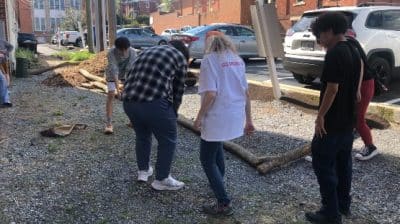
Abbie Hansberger was a new athletic trainer in Shenandoah County when the unthinkable happened. At a baseball practice in the spring, two varsity student athletes collided in the outfield, and one student, a senior, suffered a condition known as commotio cordis.
Commotio cordis is in the headlines today because it is widely speculated that Buffalo Bills player Damar Hamlin had this cardiac condition Monday night after a relatively routine tackle of a Cincinnati Bengals player.
Commotio cordis, a disruption of the heart rhythm that occurs as a result of a blow to the area directly over the heart, is rare. Approximately 30 cases are reported each year – and most are in male athletes ages 8 to 18, whose chest wall may not be fully developed.
Hansberger, now the head athletic trainer for Mary Baldwin University in Staunton, worked as an athletic trainer at Strasburg High School for 15 years. She’s also a regular on the sidelines of the Valley Baseball League with the New Market Rebels, an educator for the Valley High School League and teaches CPR to little leagues throughout the region.
Hansberger said that the instance with commotio cordis came in her first couple of years at the high school. Most injuries athletic trainers encounter are ankle sprains, ACL or non-life-threatening injuries. Things like commotio cordis are rare. The condition is covered in the classroom, but most athletic trainers never have to deal with it in their careers. Hansberger said that she did her college thesis on the condition, ironically, but still never expected to encounter it.
In 2009, she was in her athletic training room when she got a call that something very serious had occurred during baseball practice. The baseball field was about a half-mile away from the high school. She recalls it was a teacher workday, so practices were happening at irregular times.
“I get this call, and they said, ‘Abbie, it’s really bad. It’s an emergency. You have to come right now,’” Hansberger recalled in an interview with AFP.
She said that they had already called 911.
“When I arrived at the field, two of my athletes were injured in what was a routine practice. Very similar to Damar Hamlin, where it was not a ball to a chest injury but actually a collision. They had collided in the outfield.”
Hansberger said that the research on commotio cordis and what she had been taught said this usually occurs when it’s a ball off a bat or a pitch.
The team’s centerfielder was in cardiac arrest.
“My coaching staff was amazing,” she said. “You know, you always plan and prepare for the worst.”
Hansberger said that the coaching staff activated the emergency action plan, “and it’s the reason that this child is alive today.”
The senior thankfully did survive though the condition is often fatal.
The injury happened early in the week, and the student was released by the weekend. After the injury, it was a six-week process for him to get cleared for athletics. However, because of oxygen deficits, she said, he does have some short-term memory loss. He did play baseball that same season and eventually played college football at Bridgewater College. Today, he is married, and according to Hansberger, “living his best life.”
Rewinding back to the baseball field in 2009, she said that EMS responded quickly and shocked the athlete almost immediately.
“The prevalence of AEDs were not as they are today,” she said.
The rescue personnel arrived before she could get back to the school to get their AED, so she said to them as soon as they arrived, “we’ve got to get the pads on. You have to shock him now.”
They did, and he was flown to nearby Winchester Medical Center.
“It was a series of events that were executed perfectly,” she said. “Like the Damar Hamlin situation, they responded to that athlete in 10 seconds. They began CPR. They had the AED on him. They had the rescue squad on the field. The execution of an emergency action plan is the difference between life and death for athletes.
“Ultimately, if a bystander has to call 911, you can say all the information you need to give to EMS is posted right there in the dugout. It’s posted on the gym wall or wherever. That crucial information cuts down on response time.
“On that day, on that baseball field, we saw how important it is that you have an emergency action plan that everybody knows how to execute, and that it’s executed correctly in the moment of an emergency.”
While the coach at Strasburg High School was trained in CPR, it varies widely at all levels as to who is trained and who must be present at events.
Because of the national attention given to what happened on “Monday Night Football,” shown on live TV and later on TV shows and social media, she said, there seems to be a call for more people to be CPR-certified.
The best-case scenario, she said, is that the best practices trickle down to school systems and youth leagues, where sometimes it’s left to a parent in the stands to act in the case of an emergency. While Hansberger projects 70 percent of schools in Virginia have certified athletic trainers, some areas like Southwest Virginia are lacking.
“Let’s make sure these events are covered correctly so that if we have an emergency like that, you know, the outcome again, remains the same.”
After the incident at Strasburg, she said, two AEDs were donated to the school. She said that neighboring counties and athletic trainers also started taking a more serious look at access to oxygen and AEDs at their schools.
Today, she said a lot of athletic trainers do have access to oxygen. Most schools recognize the importance of having an AED within three to five minutes of any place students or athletes are.
“It’s evolved,” Hansberger said. “We’re more educated. We’re better educated as to the things that we need to have to save a life. When you know better, you do better.
“In the past 15 years, that has really been the evolution is that we now know better,” she said. “And so we do better, and we have better outcomes.”
The Buffalo Bills/Cincinnati Bengals game was postponed Monday night. Hansberger said like the NFL players we watched on TV in shock, the Strasburg baseball players also took the medical emergency very hard.
“These kids basically watched their teammate die in the outfield,” she said. “It was really hard for them to process because as a teenager you don’t really see your own mortality, or the mortality of other people, much less in something that you love, something that’s supposed to be safe. You know, you think the worst that is going to happen is you might get hit by a pitch or you might break an ankle.
“You’re not supposed to die at baseball.”
The baseball team suspended practice for most of the week, but on word that the student was doing much better, went forward with a tournament scheduled for the weekend. The student was released on Saturday and went to one of the games. His mom watched as the athletics director helped guide him to the field.
Hansberger said she told the mom not to worry. He would be OK.
“And she said, ‘I couldn’t leave him in anybody else’s hands. You guys saved him.”
Still emotional even after these years, Hansberger said that the student put on his baseball uniform, walked across the outfield to the dugout, and his teammates were so happy to see him even if he wasn’t able to be back on the field to play for some time.
This was Hansberger’s first, and to date, only encounter with commotio cordis. And she’s hoping lightning, as they say, doesn’t strike twice.
“This injury is survivable,” she said. “And you know, you can live life and thrive afterwards.”
Hansberger does her best to educate the leaders of youth sports at all levels of the importance of having AEDs present at games and practices.
She recalled a training last year with a local little league team.
“I’m going to tell you that without an AED, if you have this happen on your baseball field, this athlete is not going to survive.”
She said as an athletic trainer, what she looks for in a youth sport is likely different that what many of her peers are looking for.
“I don’t really need success on the field,” she said. “I know player development and those kind of things are important. But if my child were to play a youth sport, I want to make sure that my coaches are emergency response trained: CPR, first aid, AED … I want to know that there are venue specific emergency action plans and that those emergency action plans have been reviewed with the local EMS so that everyone is on the same page as to how we’re going to save a child’s life.”
She said that EMS responding so quickly at Strasburg was truly a miracle.
She thinks the entire medical and education system can learn from what happened on “Monday Night Football” and at Strasburg High School. While aspiring athletic trainers are taught about the rare condition in school, they are told it mostly happens as the result of blunt force trauma like a ball in an action sport like baseball, softball or lacrosse.
“I’ve watched it happen twice by collision. Maybe this is something we need to revisit and tweak how we teach it.”
Related stories
Scary NFL injury highlights need for CPR, AED training at youth-sports level










